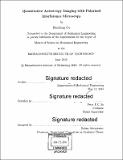| dc.contributor.advisor | Peter T.C. So. | en_US |
| dc.contributor.author | Ge, Baoliang | en_US |
| dc.contributor.other | Massachusetts Institute of Technology. Department of Mechanical Engineering. | en_US |
| dc.date.accessioned | 2018-10-22T18:46:23Z | |
| dc.date.available | 2018-10-22T18:46:23Z | |
| dc.date.copyright | 2018 | en_US |
| dc.date.issued | 2018 | en_US |
| dc.identifier.uri | http://hdl.handle.net/1721.1/118721 | |
| dc.description | Thesis: S.M., Massachusetts Institute of Technology, Department of Mechanical Engineering, 2018. | en_US |
| dc.description | Cataloged from PDF version of thesis. | en_US |
| dc.description | Includes bibliographical references (pages 83-96). | en_US |
| dc.description.abstract | Optical anisotropy measurement is essential for material characterization and biological imaging. Many optical anisotropy imaging techniques have been developed, such as fluorescence polarization microscopy(FPM), liquid crystal based polarization microscopy (LC Polscope), polarization state optical coherence tomography (ps OCT), and polarization Raman spectroscopy. Quantitative phase microscopy (QPM) is another important modality of optical imaging. By implementing interferometry, we can quantitatively map the complex field distribution of the sample with high imaging speed and high throughput. Furthermore, we can use QPM system to reconstruct the three-dimensional structure of the sample by solving inverse scattering problem. My major work is developing high speed, high sensitivity quantitative polarization imaging system. Firstly, I proposed a polarization microscope system for directly imaging sample's retardance distribution by inserting two quarter wave plates between the two crossed linear polarizers in conventional polarization microscopy, before and after the sample. This imaging concept is validated with experimental data of wave plates and liquid crystal retarders. Secondly, I proposed quantitative polarization interference microscopy (QPIM) through designing a compact polarization-resolved interference microscopy system that captures interferograms bearing sample's linear birefringence information. To extract the retardance and the orientation angle maps from a single-shot measurement, we have further developed a mathematical model for QPIM. Our QPIM system has been validated by measuring a calibrated quarterwave plate, whose fast-axis orientation angle and retardance were determined with great accuracies. We have demonstrated this application by capturing transient retardance changes in a custom-designed parallel-aligned nematic liquid crystal-based device. Finally, I proposed an imaging concept for three-dimensionally reconstruct the polarization distribution for the sample by solving anisotropic Helmholtz equation. All of these three novel imaging techniques have the potential to be applied to the study of sickle cell disease polymerization dynamics, acrosome process of crab sperms, label-free visualization of neuron action potential and semiconductor inspection in the future. | en_US |
| dc.description.statementofresponsibility | by Baoliang Ge. | en_US |
| dc.format.extent | 96 pages | en_US |
| dc.language.iso | eng | en_US |
| dc.publisher | Massachusetts Institute of Technology | en_US |
| dc.rights | MIT theses are protected by copyright. They may be viewed, downloaded, or printed from this source but further reproduction or distribution in any format is prohibited without written permission. | en_US |
| dc.rights.uri | http://dspace.mit.edu/handle/1721.1/7582 | en_US |
| dc.subject | Mechanical Engineering. | en_US |
| dc.title | Quantitative anisotropy imaging with polarized interference microscopy | en_US |
| dc.type | Thesis | en_US |
| dc.description.degree | S.M. | en_US |
| dc.contributor.department | Massachusetts Institute of Technology. Department of Mechanical Engineering | |
| dc.identifier.oclc | 1057122100 | en_US |
